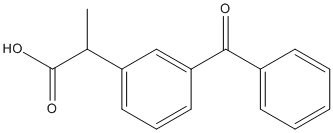Ketoprofen
General
Type : Aryl ester || Propionate
Chemical_Nomenclature : 2-(3-benzoylphenyl)propanoic acid
Canonical SMILES : CC(C1=CC=CC(=C1)C(=O)C2=CC=CC=C2)C(=O)O
InChI : InChI=1S\/C16H14O3\/c1-11(16(18)19)13-8-5-9-14(10-13)15(17)12-6-3-2-4-7-12\/h2-11H,1H3,(H,18,19)
InChIKey : DKYWVDODHFEZIM-UHFFFAOYSA-N
Other name(s) : 2-(3-Benzoylphenyl)propanoic acid, Orudis, M-Benzoylhydratropic acid, 2-(3-Benzoylphenyl)propionic acid

Target
Families : No family
References (2)
| Title : Identification of human, rat and mouse hydrolyzing enzymes bioconverting amino acid ester prodrug of ketoprofen - Huttunen_2018_Bioorg.Chem_81_494 |
| Author(s) : Huttunen KM |
| Ref : Bioorg Chem , 81 :494 , 2018 |
| Abstract : Huttunen_2018_Bioorg.Chem_81_494 |
| ESTHER : Huttunen_2018_Bioorg.Chem_81_494 |
| PubMedSearch : Huttunen_2018_Bioorg.Chem_81_494 |
| PubMedID: 30243240 |
| Title : Enantioseparation of (R,S)-ketoprofen using Candida antarctica lipase B in an enzymatic membrane reactor - Ong_2008_J.Sep.Sci_31_2476 |
| Author(s) : Ong AL , Kamaruddin AH , Bhatia S , Aboul-Enein HY |
| Ref : J Sep Sci , 31 :2476 , 2008 |
| Abstract : Ong_2008_J.Sep.Sci_31_2476 |
| ESTHER : Ong_2008_J.Sep.Sci_31_2476 |
| PubMedSearch : Ong_2008_J.Sep.Sci_31_2476 |
| PubMedID: 18646277 |